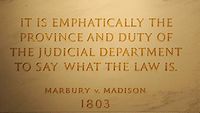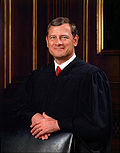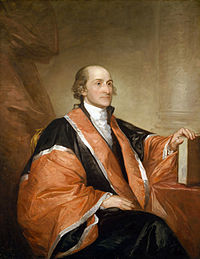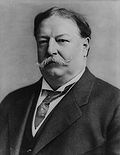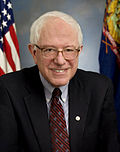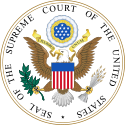- Portal:Supreme Court of the United States
-
- Wikipedia portals:
- Culture
- Geography
- Health
- History
- Mathematics
- Natural sciences
- People
- Philosophy
- Religion
- Society
- Technology
Supreme Court of the United States Portal
Inscription from
Marbury v. MadisonThe Supreme Court of the United States is the highest judicial body in the United States and leads the judicial branch of the United States federal government. The Justices are nominated by the President and confirmed with the "advice and consent" of the Senate. They are appointed to serve "during good behavior," which means for life, and leave office only upon death, retirement, resignation, or impeachment and subsequent conviction. The Supreme Court holds both original and appellate jurisdiction, with its appellate jurisdiction accounting for most of the Court's caseload. The Supreme Court meets in Washington, D.C., in the United States Supreme Court building. The Court's yearly terms usually start on the first Monday in October and finish sometime during the following June or July. Each term consists of alternating two week intervals. During the first interval, the court is in session and hears cases, and during the second interval, the court is recessed to consider and write opinions on cases they have heard.
More about the Supreme Court of the United States... Selected article
Citizens United v. Federal Election Commission, 558 U.S. 08-205 (2010), was a landmark decision by the United States Supreme Court holding that corporate funding of independent political broadcasts in candidate elections cannot be limited—because of the First Amendment. The majority opinion was written by Chief Justice John Roberts (pictured). The 5–4 decision, in favor of Citizens United, resulted from a dispute over whether the non-profit corporation Citizens United could air a film critical of Hillary Clinton, and whether the group could advertise the film in broadcast ads featuring Clinton's image, in apparent violation of the 2002 Bipartisan Campaign Reform Act, commonly known as the McCain–Feingold Act. The decision reached the Supreme Court on appeal from a January 2008 decision by the United States District Court for the District of Columbia. The lower court decision upheld provisions of the McCain–Feingold Act which prevented the film Hillary: The Movie from being shown on television within 30 days of 2008 Democratic primaries. The Court struck down a provision of the McCain–Feingold Act that prohibited all corporations, both for-profit and not-for-profit, and unions from broadcasting “electioneering communications.” An "electioneering communication" was defined in McCain–Feingold as a broadcast, cable, or satellite communication that mentioned a candidate within 60 days of a general election or thirty days of a primary. The decision overruled Austin v. Michigan Chamber of Commerce (1990) and partially overruled McConnell v. Federal Election Commission (2003). McCain–Feingold had previously been weakened, without overruling McConnell, in Federal Election Commission v. Wisconsin Right to Life, Inc. (2007). The Court did uphold requirements for disclaimer and disclosure by sponsors of advertisements. The case did not involve the federal ban on direct contributions from corporations or unions to candidate campaigns or political parties.Selected picture
John Jay, first Chief Justice of the Supreme Court.
In this month
- November 1, 2005 – Oral arguments heard in Gonzales v. O Centro Espirita Beneficente Uniao do Vegetal, regarding an application of the Religious Freedom Restoration Act.
- November 13, 1856 – Birth of Louis Brandeis (pictured), Associate Justice on the Court from 1916 to 1939.
- November 28, 1975 – Nomination by President Gerald Ford of John Paul Stevens to the Court.
- November 28, 2006 – Argument of KSR v. Teleflex before the Court, concerning the issue of obviousness as applied to patent claims.
More anniversaries...Did you know...
- ... that in his dissenting opinion in the case of Taylor v. Beckham, U.S. Supreme Court justice John Marshall Harlan wrote that the right to hold elected offices should be considered part of the definition of "liberty" and protected by the Fourteenth Amendment (pictured)?
- ...that the Supreme Court case Radovich v. National Football League, which held professional football subject to antitrust law, began with a brief drafted on the back of a napkin?
- ... that in FCC v. AT&T Inc., the Supreme Court struck a blow to corporate personhood and held that corporations cannot claim exempt status from Freedom of Information Act requests?
Selected biography
William Howard Taft (1857 – 1930) was the 27th President of the United States (1909–1913) and later the tenth Chief Justice of the United States (1921–1930). He is the only person to have served in both offices. Born in 1857 in Cincinnati, Ohio, into the powerful Taft family, "Big Bill" graduated from Yale College Phi Beta Kappa in 1878, and from Cincinnati Law School in 1880. He worked in a number of local non-descript legal positions until he was tapped to serve on the Ohio Supreme Court in 1887. In 1890, Taft was appointed Solicitor General of the United States and in 1891 a judge on the United States Court of Appeals for the Sixth Circuit. In 1900, President William McKinley appointed Taft Governor-General of the Philippines. In 1904, President Theodore Roosevelt appointed Taft Secretary of War with the hope that he might groom Taft, his then close political ally, into his hand-picked presidential successor. Riding a wave of popular support of President (and fellow Republican) Theodore Roosevelt, Taft won an easy victory in his 1908 bid for the presidency. Taft often alienated his own key constituencies, and was overwhelmingly defeated in his bid for a second term in the presidential election of 1912. In 1921, after the First World War, President Warren G. Harding appointed Taft Chief Justice of the United States. Taft served in this capacity until shortly before his death in 1930. As such, he is the only former President to administer the oath of office to another President, and the only Chief Justice to serve with associate justices whom he himself had earlier appointed to the court.News
Categories
Wikiprojects
- Parent project
- United States History

- Main project
- U.S. Supreme Court cases
- Related projects
- Crime
- Human rights
- Law
- United States
- United States courts and judges
- United States Government
What are WikiProjects?Selected quote
Topics
Supreme Court of the United States The Court Current
membershipRetired Associate JusticesAll members List of all members (by court • by seat • by time in office) · List of Chief Justices (by time in office) · Timeline
All nominations · Unsuccessful nominations · Court demographicsCourt functionaries Recognized content
Featured articles
Featured lists
Good articles
 Legal Services Corp. v. Velazquez
Legal Services Corp. v. Velazquez Mayo Foundation v. United States
Mayo Foundation v. United States Menominee Tribe v. United States
Menominee Tribe v. United States Merrion v. Jicarilla Apache Tribe
Merrion v. Jicarilla Apache Tribe NLRB v. J. Weingarten, Inc.
NLRB v. J. Weingarten, Inc. Taylor v. Beckham
Taylor v. Beckham United States v. Lara
United States v. Lara United States v. Wong Kim Ark
United States v. Wong Kim Ark Vance v. Terrazas
Vance v. Terrazas Yasui v. United States
Yasui v. United States
Things you can do

- Add {{Portal|Supreme Court of the United States}} to the See also section of Supreme Court of the United States-related articles.
- Tag the talk pages of Supreme Court of the United States-related articles with {{WP SCOTUS}}
- Join WikiProject U.S. Supreme Court cases and list yourself as a Participant in the project.
- Check the recent changes page for improvements, other changes, and vandalism to these articles
- Deletion discussions: listed at Wikipedia:WikiProject Deletion sorting/Law
- Notability: Articles with notability concerns, listed at WikiProject Notability
- Rate the Unassessed Supreme Court of the United States articles in the WikiProject U.S. Supreme Court cases.
- Stubs: Supreme Court of the United States stubs
Related portals
Criminal justice Government of the United States Human rights Law Society Sociology United States Associated Wikimedia
Categories:- Supreme Court of the United States portal
Wikimedia Foundation. 2010.

